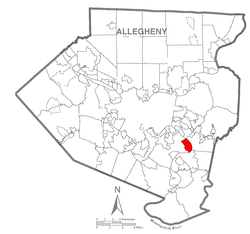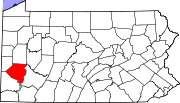- Duquesne, Pennsylvania
-
Duquesne, Pennsylvania Location in Allegheny County, Pennsylvania Location within the state of Pennsylvania Coordinates: 40°22′12″N 79°51′3″W / 40.37°N 79.85083°WCoordinates: 40°22′12″N 79°51′3″W / 40.37°N 79.85083°W Country United States Commonwealth Pennsylvania County Allegheny Settled 1885 Incorporated September 12, 1891 (borough) January 7, 1918 (city) Area – Total 2.0 sq mi (5.3 km2) – Land 1.8 sq mi (4.7 km2) – Water 0.2 sq mi (0.6 km2) Population (2010) – Total 5,565 – Density 2,719.5/sq mi (1,050/km2) Time zone EST (UTC-5) – Summer (DST) EDT (UTC-4) Duquesne (
 /duːˈkeɪn/) is a city along the Monongahela River in Allegheny County, Pennsylvania, United States, and is part of the Pittsburgh Metropolitan Area. The population was 5,565 at the 2010 census.[1]
/duːˈkeɪn/) is a city along the Monongahela River in Allegheny County, Pennsylvania, United States, and is part of the Pittsburgh Metropolitan Area. The population was 5,565 at the 2010 census.[1]Contents
History
The borough of Duquesne was settled in 1789[2] and incorporated in 1891. Its population in 1900 was 9,036; in 1910, 15,727; in 1920, 19,011; in 1930, 21,000; and in 1940, 20,693.
Duquesne Works, a productive steel mill that was part of Carnegie Steel Corporation and later part of U.S. Steel, was the heart and soul of Duquesne during its brightest moments in the early 20th century. Duquesne was home to the largest blast furnace in the world, named the "Dorothy Six".[3] The city's population peaked in 1930, then declined with deindustrialization beginning in the 1960s. Today a stark post-industrial landscape, Duquesne has fewer total residents (5,565 at the 2010 U.S. census) than were the city's mill workers in 1948.[4] According to the McKeesport Daily News, Duquesne has the worst performing schools in the state of Pennsylvania. Duquesne was designated a financially distressed municipality in 1991 by the state.
Duquesne High School closed in 2007. Beginning with the 2007-08 school year, Duquesne students have reported to West Mifflin Area High School, or East Allegheny High School. Since July 2007, the Allegheny Intermediate Unit (AIU) has managed all academic and business operations of the Duquesne's K-8 school district.
Geography
Duquesne is located at 40°22′12″N 79°51′3″W / 40.37°N 79.85083°W (40.369969, -79.850957).[5] Duquesne is nestled along the Monongahela River approximately 12 miles (19 km) south of Pittsburgh.
According to the United States Census Bureau, the city has a total area of 2.0 square miles (5.2 km2), of which 1.8 square miles (4.7 km2) is land and 0.2 square miles (0.52 km2), or 10.84%, is water.
Demographics
As of the census[6] of 2000, there were 7,332 people, 3,179 households, and 1,853 families residing in the city. The population density was 4,035.0 people per square mile (1,555.4/km²). There were 3,768 housing units at an average density of 2,073.7 per square mile (799.4/km²). The racial makeup of the city was 38.92% White, 57.75% African American, 0.15% Native American, 0.14% Asian, 0.01% Pacific Islander, 0.74% from other races, and 2.29% from two or more races. Hispanic or Latino of any race were 0.72% of the population.
There were 3,179 households out of which 28.1% had children under the age of 18 living with them, 25.8% were married couples living together, 27.2% had a female householder with no husband present, and 41.7% were non-families. 37.2% of all households were made up of individuals and 18.6% had someone living alone who was 65 years of age or older. The average household size was 2.28 and the average family size was 3.00.
In the city the population was spread out with 28.3% under the age of 18, 9.6% from 18 to 24, 24.3% from 25 to 44, 18.6% from 45 to 64, and 19.2% who were 65 years of age or older. The median age was 36 years. For every 100 females there were 80.3 males. For every 100 females age 18 and over, there were 75.1 males.
The median income for a household in the city was $19,766, and the median income for a family was $25,898. Males had a median income of $25,046 versus $22,272 for females. The per capita income for the city was $12,067. About 31.3% of families and 34.7% of the population were below the poverty line, including 52.9% of those under age 18 and 19.7% of those age 65 or over.
Notable people
- Earl Hines, jazz pianist
- Frederick J. Osterling, architect
- Alex Shigo, horticulturist
References
- ^ "Race, Hispanic or Latino, Age, and Housing Occupancy: 2010 Census Redistricting Data (Public Law 94-171) Summary File (QT-PL), Duquesne city, Pennsylvania". U.S. Census Bureau, American FactFinder 2. http://factfinder2.census.gov. Retrieved September 8, 2011.
- ^ "Allegheny County - 2nd class" (PDF). Pennsylvania Historical and Museum Commission. http://www.phmc.state.pa.us/bah/dam/counties/pdfs/Allegheny.pdf. Retrieved 2007-05-24.
- ^ The furnace's official name was Dorothy, after Dorothy Worthington, wife of the then-current USS CEO. "#6" was what the furnace was called by everyone who worked in Duquesne, referring to it being the sixth blast furnace built in Duquesne.
- ^ ExplorePaHistory.com, s.v. Duquesne Steel Works
- ^ "US Gazetteer files: 2010, 2000, and 1990". United States Census Bureau. 2011-02-12. http://www.census.gov/geo/www/gazetteer/gazette.html. Retrieved 2011-04-23.
- ^ "American FactFinder". United States Census Bureau. http://factfinder.census.gov. Retrieved 2008-01-31.
External links
- G.M. Hopkins Map: South Eastern Vicinity of Pittsburgh, 1900
- photographs of Duquesne steel mill blast furnaces, 1992
Municipalities and communities of Allegheny County, Pennsylvania Cities Clairton | Duquesne | McKeesport | Pittsburgh
Boroughs Aspinwall | Avalon | Baldwin | Bell Acres | Bellevue | Ben Avon | Ben Avon Heights | Bethel Park | Blawnox | Brackenridge | Braddock | Braddock Hills | Bradford Woods | Brentwood | Bridgeville | Carnegie | Castle Shannon | Chalfant | Cheswick | Churchill | Coraopolis | Crafton | Dormont | Dravosburg | East McKeesport | East Pittsburgh | Edgewood | Edgeworth | Elizabeth | Emsworth | Etna | Forest Hills | Fox Chapel | Franklin Park | Glassport | Glen Osborne | Glenfield | Green Tree | Haysville | Heidelberg | Homestead | Ingram | Jefferson Hills | Leetsdale | Liberty | Lincoln | McDonald‡ | McKees Rocks | Millvale | Monroeville | Mount Oliver | Munhall | North Braddock | Oakdale | Oakmont | Pennsbury Village | Pitcairn | Pleasant Hills | Plum | Port Vue | Rankin | Rosslyn Farms | Sewickley | Sewickley Heights | Sewickley Hills | Sharpsburg | Springdale | Swissvale | Tarentum | Thornburg | Trafford‡ | Turtle Creek | Verona | Versailles | Wall | West Elizabeth | West Homestead | West Mifflin | West View | Whitaker | White Oak | Whitehall | Wilkinsburg | Wilmerding
Townships Aleppo | Baldwin | Collier | Crescent | East Deer | Elizabeth | Fawn | Findlay | Forward | Frazer | Hampton | Harmar | Harrison | Indiana | Kennedy | Kilbuck | Leet | Marshall | McCandless | Moon | Mt. Lebanon | Neville | North Fayette | North Versailles | O'Hara | Ohio | Penn Hills | Pine | Reserve | Richland | Robinson | Ross | Scott | Shaler | South Fayette | South Park | South Versailles | Springdale | Stowe | Upper St. Clair | West Deer | Wilkins
CDPs Allison Park | Bairdford | Bakerstown | Carnot-Moon | Clinton | Curtisville | Enlow | Gibsonia | Glenshaw | Harwick | Imperial | Noblestown | Rennerdale | Russellton | Sturgeon
Unincorporated
communitiesAcmetonia | Blackridge | Blanchard | Broughton | Bruceton | Buena Vista | Creighton | Dorseyville | Elfinwild | Harmarville | Hickory Heights | Karns | Keown Station | Natrona | Natrona Heights | Warrendale | Wexford | Wildwood
Footnotes ‡This populated place also has portions in an adjacent county or counties
Categories:- Cities in Pennsylvania
- Populated places established in 1789
- Pittsburgh metropolitan area
- Populated places in Allegheny County, Pennsylvania
Wikimedia Foundation. 2010.



